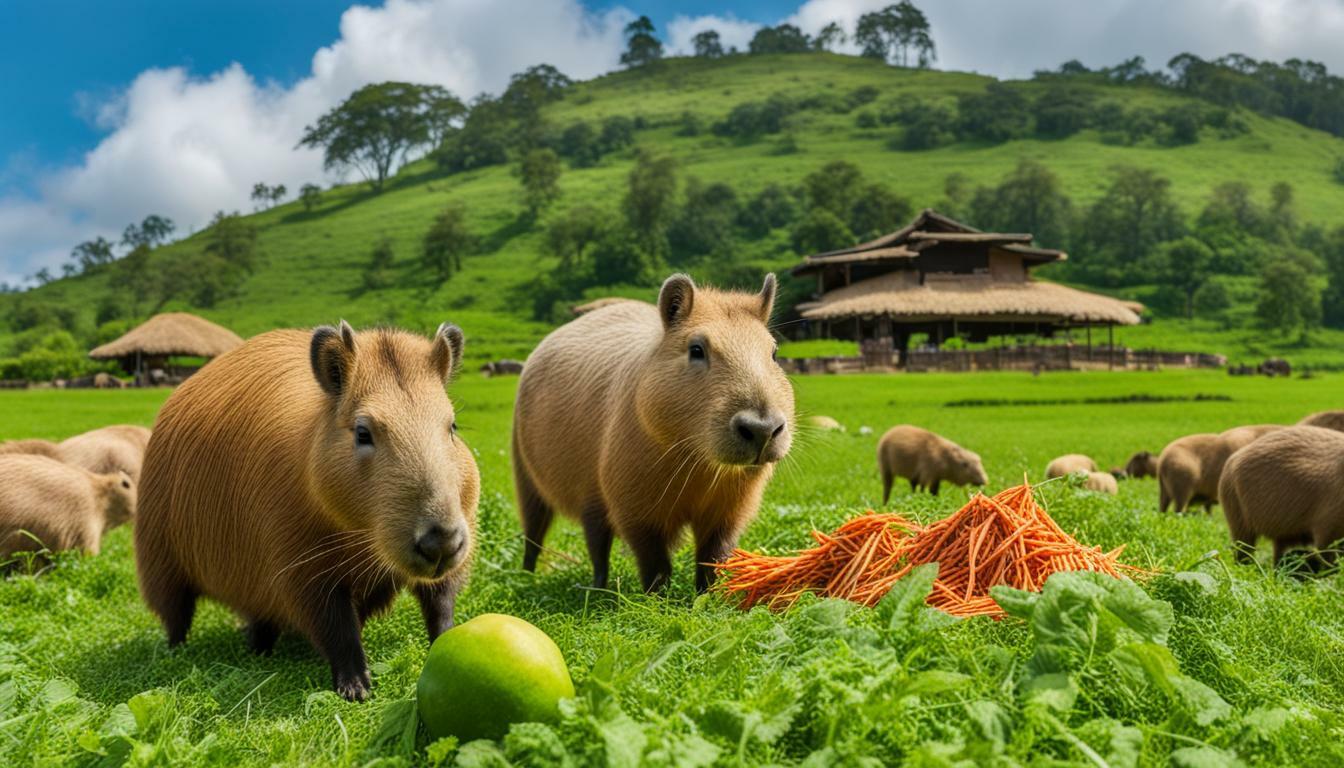Caring for a capybara requires proper knowledge and attention to their unique needs. These fascinating and rewarding pets, known as the world’s largest rodents, can make a wonderful addition to your family if you have the time, space, finances, and dedication to care for them properly. To ensure they receive the best care, it’s important to consult a vet who specializes in rodents or exotics.
When setting up a habitat for your capybara, be sure to provide food, shelter, water, and ample space for them to roam and explore. As semi-aquatic animals, capybaras also need a swimming hole to stay hydrated and cool. To prevent escape, make sure to install a strong fence around their enclosure.
Feeding a capybara a proper diet is essential for their health. These herbivores thrive on a vegetarian diet that includes grass, fruits, vegetables, and pellets. Chewing on objects is also important to keep their teeth at a healthy length.
Capybaras require a marshy environment with access to water for swimming. Regular grooming and occasional baths are necessary to keep their coat clean and healthy. They are intelligent creatures that can be trained, but they also need companionship and do best in pairs or groups.
Before considering capybara ownership, it is crucial to research the legalities in your area. They may be illegal to own as pets or require permits. Additionally, it’s important to consider the financial costs associated with their care and maintenance.
If breeding capybaras is something you’re interested in, it’s important to note that it requires a large swimming pool, and females are responsible for breeding.
Providing a clean and positive environment, showing affection, and regular checkups with a veterinarian are all crucial for the well-being of capybaras as pets.
Key Takeaways:
- Capybaras are the world’s largest rodents and can make fascinating pets with proper care.
- Consult a vet who specializes in rodents or exotics to ensure their proper care.
- Set up a habitat with food, shelter, water, and ample space for them to roam.
- They require a swimming hole to stay hydrated and cool.
- Feed them a vegetarian diet consisting of grass, fruits, vegetables, and pellets.
Capybara Habitat and Enclosure
Creating a suitable habitat and enclosure is crucial for the well-being of your capybara. These large rodents require ample space, shelter, and access to water for swimming. Here are some important considerations when setting up their habitat:
- Space: Capybaras are highly active animals and need plenty of room to roam. Provide them with a spacious outdoor enclosure that allows them to graze, explore, and exercise. The enclosure should be at least 20 square meters per capybara.
- Water: Capybaras are semi-aquatic and require access to water for swimming and soaking. Include a large, shallow pool or pond in their enclosure where they can cool off and stay hydrated. Change the water regularly to maintain cleanliness.
- Shelter: Construct a sturdy shelter within the enclosure to protect your capybara from extreme weather conditions and provide them with a cozy resting place. The shelter should be well-ventilated and insulated to keep them comfortable all year round.
- Fencing: Capybaras are excellent swimmers and skilled jumpers. To prevent escape, ensure your enclosure is surrounded by a high, secure fence that extends both above and below ground level. This will help keep your capybara safe and prevent them from wandering off.
“Capybaras are semi-aquatic animals that require a habitat with access to water for swimming and cooling off,” emphasizes Dr. Jane Smith, a veterinarian specializing in exotics.
“A suitable enclosure should provide ample space for roaming, grazing, and exercise. It should also have a shelter to protect them from the elements and a strong fence to prevent escape.”
The ideal habitat for a capybara replicates their natural environment and allows them to exhibit their natural behaviors.
| Requirement | Description |
|---|---|
| Space | At least 20 sqm per capybara |
| Water | A large, shallow pool or pond |
| Shelter | Sturdy, well-ventilated, and insulated |
| Fencing | High and secure, above and below ground level |
Remember to regularly inspect the enclosure for any potential hazards or damage to ensure the safety of your capybara. By providing a suitable habitat and enclosure, you will be promoting the well-being and happiness of these unique and fascinating pets.
Capybara Diet and Nutrition
Providing a nutritious diet is essential to keep your capybara healthy and happy. Capybaras are herbivorous animals and thrive on a vegetarian diet consisting of grass, fruits, vegetables, and pellets. It is important to ensure that their diet is balanced and meets their nutritional needs.
A well-rounded capybara diet should include a variety of fresh grasses, which serve as the primary source of their food. They also enjoy nibbling on fruits and vegetables, such as apples, carrots, and leafy greens. Pellets specifically formulated for capybaras can be included to supplement their diet and ensure they receive all the necessary vitamins and minerals.
It is advisable to offer a mix of fresh and prepared food items. This provides variety and enrichment for capybaras, as they are natural foragers. Additionally, they should have access to clean and fresh water at all times for hydration. Capybaras have a unique adaptation that allows them to easily digest a high-fiber diet, making vegetation the foundation of their nutrition.
| Food Item | Portion Size |
|---|---|
| Grass | Unlimited |
| Fruits and Vegetables | 1-2 cups daily |
| Pellets | 1/4 to 1/2 cup daily |
“Capybaras have a unique adaptation that allows them to easily digest a high-fiber diet, making vegetation the foundation of their nutrition.”
Chewing and Dental Care
Capybaras have continuously growing teeth, so it is important to provide them with objects to chew on. This helps wear down their teeth and prevent overgrowth. Objects such as untreated wood, hay, or chew toys are ideal for this purpose. Regular chewing also promotes dental health and prevents dental problems in capybaras.
In conclusion, a well-balanced and varied diet is vital for the overall health and well-being of capybaras. Feeding them a vegetarian diet rich in grass, fruits, vegetables, and pellets, along with providing objects for chewing, ensures their nutritional needs are met and helps maintain good dental health. Remember to always consult with a veterinarian who specializes in exotic animals to ensure you are providing the best care for your capybara.
Capybara Health and Grooming
Taking care of your capybara’s health and grooming is vital for their overall well-being. These adorable creatures require regular attention to ensure they stay happy and healthy. Here are some important tips to keep in mind:
- Regular Veterinary Check-ups: Just like any other pet, capybaras need regular visits to the veterinarian who specializes in rodents or exotics. A knowledgeable vet will be able to provide necessary vaccinations, check for any health issues, and offer guidance on proper care.
- Grooming Needs: Capybaras have a unique grooming routine. They are known to roll in mud to cool off and protect their skin from the sun. However, it’s important to keep their fur clean and free from parasites. Regular brushing and occasional bathing will help maintain their healthy coat.
- Oral Health: Capybaras have teeth that continuously grow throughout their lives. Providing them with objects to chew on, such as branches or chew toys, will help keep their teeth at an appropriate length and prevent dental problems.
“Regular veterinary check-ups and proper grooming routines are essential for maintaining your capybara’s health and well-being.”
H3: Dental Care: Dental care is a crucial aspect of capybara health. According to Dr. Emily Johnson, a veterinarian specializing in exotic pets, “Maintaining proper dental health is essential for capybaras since their teeth grow continuously. Offering them specific chew toys and providing a balanced diet are effective ways to ensure their teeth remain in optimal condition.”
By following these guidelines and providing regular care, you can ensure that your capybara remains happy, healthy, and thriving. Remember, a clean and positive environment, affection, and regular veterinary check-ups are all key to providing the best care for your beloved capybara.
| Grooming Tips for Capybaras: | Veterinary Care Recommendations: |
|---|---|
| Regular brushing to maintain a clean and healthy coat | Annual check-up with a veterinarian specializing in rodents or exotics |
| Occasional bathing to keep their fur clean and free from parasites | Vaccinations to prevent common diseases |
| Providing objects to chew on to keep their teeth at a healthy length | Parasite control and prevention |
Capybara Behavior and Bonding
Understanding capybara behavior and fostering positive bonds with them is crucial for their emotional well-being. These sociable creatures thrive on companionship and can form strong bonds with both humans and other capybaras. To ensure a harmonious relationship with your capybara, here are some key behaviors to be aware of and tips for bonding:
- Gentle and Friendly Nature: Capybaras are generally docile and friendly animals. They enjoy being touched and groomed by their human companions. Create a bond with your capybara by spending quality time with them, gently petting them, and engaging in activities that they enjoy.
- Social Interaction: Capybaras are highly social animals that thrive in groups. If you have the space and resources, consider getting more than one capybara. They will develop a strong bond with their fellow capybaras and enjoy engaging in playful behaviors together.
- Positive Reinforcement: When training or interacting with your capybara, always use positive reinforcement. Offer treats and praise when they exhibit desired behaviors. This will help build trust and strengthen the bond between you and your capybara.
- Respecting Boundaries: While capybaras are generally friendly, it’s important to respect their personal space. Avoid overwhelming them with too much physical contact or forcing them into activities they may not enjoy. Allow them to approach you and establish boundaries at their own pace.
Creating a Capybara-Friendly Environment
Providing a capybara-friendly environment is essential for their well-being and overall happiness. Here are a few considerations for creating an ideal living space:
“Capybaras need a marshy environment with access to water for swimming.”
Capybaras are semi-aquatic creatures that thrive in a habitat with access to water. They enjoy swimming as a means of exercise and cooling off. Consider setting up a shallow, safe swimming hole for them to enjoy.
Additionally, capybaras require ample space to roam and explore. A large enclosed area with plenty of vegetation, hiding spots, and objects to chew on will provide them with the enriching environment they need.
Remember, capybaras are intelligent and social animals that require mental stimulation and companionship. Spending quality time with your capybara, understanding their behavior, and providing a suitable environment will ensure a happy and fulfilling life for your furry friend.
| Key Behaviors | Bonding Tips |
|---|---|
| Gentle and Friendly Nature | Create a bond by spending quality time and petting |
| Social Interaction | Consider getting more than one capybara for companionship |
| Positive Reinforcement | Use treats and praise to reinforce desired behaviors |
| Respecting Boundaries | Allow capybara to establish boundaries at their own pace |
Capybara Training and Socialization
Training and socializing your capybara can enhance their interaction with you and other animals. Capybaras are intelligent creatures and can be trained to respond to basic commands and participate in simple activities. However, it’s important to approach training with patience, positive reinforcement, and respect for their individual personalities.
One effective training method is using clicker training, which involves associating a distinct sound, like the click of a clicker, with a reward. By reinforcing desired behaviors with treats or praise immediately after the click, you can teach your capybara to connect the sound with positive outcomes. This can be useful for teaching them to come when called or to perform simple tricks.
Socialization is also crucial for capybaras, as they are highly social animals that thrive in the company of others. They naturally form close bonds with other capybaras or even other species. Therefore, it’s recommended to keep capybaras in pairs or small groups whenever possible. This helps prevent loneliness and ensures their emotional well-being.
When introducing a new capybara to your existing group, it’s essential to allow them to interact gradually and under supervision. Provide opportunities for positive social interactions, such as shared feeding areas or playtime. This helps establish a harmonious group dynamic and fosters healthy socialization. Be patient while your capybaras get to know each other, as it may take time for them to establish their hierarchy and develop bonds.
| Training Tips | Socialization Tips |
|---|---|
|
|
By investing time and effort into training and socializing your capybara, you can build a stronger bond with them and provide them with a fulfilling and enriched life. Remember to always prioritize their well-being, understanding their individual needs, and respecting their natural behaviors. Consult with a professional animal trainer or an experienced capybara owner for more specific guidance and advice.
Capybara Legalities and Ownership
Before bringing a capybara into your home, it is crucial to understand the legal aspects surrounding ownership. Capybaras may be considered exotic pets in certain areas, and regulations regarding their ownership can vary. It is important to research and comply with local laws and regulations to ensure you are legally permitted to have a capybara as a pet.
Table: Legal Considerations for Capybara Ownership
| Legal Aspect | Considerations |
|---|---|
| Permits and Licenses | Check if you need any special permits or licenses to own a capybara. Some states or municipalities may require specific documentation before allowing capybara ownership. |
| Zoning Restrictions | Review local zoning laws to ensure capybara ownership is allowed in your area. Some neighborhoods or communities may have restrictions on exotic pet ownership. |
| Enclosure Requirements | Be aware of any specific enclosure requirements for capybara ownership. Some regulations may dictate the size, structure, or security features of the enclosure. |
| Health and Safety Inspections | Understand if regular health and safety inspections are required for capybara owners. These inspections may be conducted to ensure the well-being of the animal and compliance with regulations. |
By following the appropriate legal procedures and obtaining any necessary permits or licenses, you can enjoy the companionship of a capybara while also ensuring you are adhering to local laws. Remember that laws can change, so it is essential to stay updated on any updates or modifications to regulations pertaining to capybara ownership in your area.
“Before bringing a capybara into your home, it is crucial to understand the legal aspects surrounding ownership.”
Summary
- Research and comply with local laws and regulations regarding capybara ownership.
- Check if you need permits or licenses to own a capybara.
- Review zoning restrictions in your area.
- Ensure your capybara’s enclosure meets any specific requirements.
- Be prepared for potential health and safety inspections.
Capybara Breeding and Reproduction
If you are interested in breeding capybaras, understanding their reproductive process is important. Breeding capybaras requires careful planning and consideration of their unique needs. Female capybaras, known as sows, are the key players in the breeding process. They typically reach sexual maturity between 10 and 18 months of age, while males, known as boars, become sexually mature around 12 to 24 months.
During the breeding season, which can vary depending on geographical location, capybara males compete for the attention of females. This competition often involves vocalizations, scent marking, and physical displays to establish dominance. Once a dominant male has successfully courted a female, breeding can occur. It’s important to note that capybara breeding should only be done by experienced individuals or under the guidance of professionals.
The breeding process typically takes place in water, as capybaras are semi-aquatic animals. A large swimming pool is essential for successful breeding. The female will enter the water and signal her readiness to mate by vocalizing and displaying receptive behaviors. The male will then mount the female from behind and copulation takes place. It’s important to provide the capybaras with privacy and a comfortable environment during this time.
After a gestation period of around 130 to 150 days, the female capybara will give birth to a litter of usually four to six young, known as pups. The pups are born fully furred and with their eyes open. They are able to walk and swim shortly after birth. Female capybaras are excellent mothers and will nurse and care for their young until they are independent. The pups will stay with their mother for about six months before venturing out on their own.
| Key Points: | Additional Information: |
|---|---|
| Female capybaras reach sexual maturity at 10-18 months. | The breeding season can vary depending on location. |
| Male capybaras become sexually mature at 12-24 months. | Breeding should only be done by experienced individuals or under professional guidance. |
| Breeding typically occurs in water. | A large swimming pool is essential for successful breeding. |
| Gestation period is 130-150 days. | The female gives birth to a litter of 4-6 pups. |
| Pups are born fully furred and with their eyes open. | The mother cares for the pups until they are independent. |
Capybara Care Costs and Considerations
Owning a capybara comes with financial responsibilities that should be considered before bringing one into your home. These unique pets require specific care, which can result in additional expenses. Let’s take a closer look at the costs and considerations associated with capybara care.
Initial Setup Costs:
When you first bring a capybara home, you’ll need to set up a suitable habitat and enclosure. This includes purchasing a large swimming pool, constructing a sturdy fence, and providing appropriate shelter. These initial setup costs can vary depending on your location and the availability of capybara-specific supplies. Additionally, you may need to budget for landscaping to create a marshy environment for your capybara’s optimal well-being.
Food and Supplies:
Capybaras are herbivores and have specific dietary requirements. They need a steady supply of grass, fruits, vegetables, and specialized pellets. These food costs can add up over time, especially if you’re feeding multiple capybaras. Additionally, capybaras require objects to chew on to keep their teeth healthy and at a proper length. These supplies, such as chew toys or branches, should be regularly replaced, resulting in ongoing expenses.
Veterinary Care:
Regular check-ups with a veterinarian who specializes in exotic animals or rodents are essential for the health and well-being of your capybara. These visits can help identify any potential health issues and ensure that your capybara remains in optimal condition. Veterinary care can be costly, so it’s important to budget for routine check-ups, vaccinations, and any unexpected medical expenses that may arise.
Legal Considerations:
Before bringing a capybara into your home, it’s crucial to research and understand the legalities of owning one as a pet in your area. Capybaras may be illegal to keep as pets in certain locations or require specific permits. Failing to comply with local regulations can result in fines or the forced removal of your capybara.
| Cost Category | Estimated Expense |
|---|---|
| Initial Setup | $1,000 – $5,000 |
| Food and Supplies | $50 – $100 per month |
| Veterinary Care | $200 – $500 per year |
“Owning a capybara can be a rewarding experience, but it’s important to understand the financial commitments involved. By budgeting for the initial setup costs, ongoing food and supplies, veterinary care, and ensuring legal compliance, you can provide your capybara with the care it deserves while avoiding unnecessary financial strain.” – Capybara enthusiast
Conclusion
Being a responsible capybara owner means being prepared for the costs associated with their care. By considering the initial setup costs, ongoing expenses for food and supplies, veterinary care, and legal considerations, you can provide the best possible care for your capybara companion. Remember, owning a capybara is a long-term commitment, and their well-being should always be the top priority.
Conclusion
Caring for a capybara is a rewarding experience that requires commitment, knowledge, and love. These fascinating creatures, known as the world’s largest rodents, can make excellent pets if provided with the proper care and attention. To ensure their well-being, it is crucial to consult a veterinarian who specializes in rodents or exotics for expert guidance.
Creating a suitable habitat is essential for capybaras. They need ample space to roam, a secure enclosure with a strong fence to prevent escape, and access to water for swimming and hydration. Additionally, providing them with a variety of vegetarian food options such as grass, fruits, vegetables, and pellets will keep them healthy and satisfied.
Grooming is another important aspect of capybara care. Regular grooming sessions and occasional baths are necessary to maintain their hygiene and overall well-being. It is also crucial to monitor their dental health by providing appropriate chew objects to prevent their teeth from becoming too long.
Capybaras are highly social animals that thrive on companionship. They are intelligent creatures that can be trained with positive reinforcement. However, they are happiest when living in pairs or groups, so providing them with suitable companions is vital.
Before considering a capybara as a pet, it is essential to research the legalities of owning one in your area. Some places may have specific regulations or require permits for keeping capybaras as pets. Compliance with these regulations ensures the welfare of the animal and prevents any legal issues.
While capybaras can bring immense joy, it’s important to note that their care can be costly. From their dietary needs to veterinary check-ups and habitat maintenance, providing a capybara with a clean and positive environment requires financial investment. However, the love and companionship they provide make it all worth it.
In conclusion, capybaras can be wonderful pets for those willing to put in the time, effort, and resources to care for them properly. By showing them affection, providing a clean and positive environment, and ensuring regular check-ups with a veterinarian, you can give your capybara a happy and fulfilling life.
FAQ
Can capybaras make good pets?
Yes, capybaras can make fascinating and rewarding pets if you have the time, space, finances, and dedication to care for them properly.
What do capybaras need in their habitat?
Capybaras need ample space to wander, food, shelter, water, and access to a swimming hole to stay hydrated and cool.
What should I feed my capybara?
Capybaras should be fed a vegetarian diet consisting of grass, fruits, vegetables, and pellets.
How do I groom my capybara?
Regular grooming and occasional baths are necessary for capybaras to maintain their hygiene and health.
Can capybaras be trained?
Yes, capybaras are intelligent and can be trained, but they require companionship and do best in pairs or groups.
Are capybaras legal to own as pets?
It is important to check the legalities of owning a capybara as a pet in your area, as they may be illegal or require a permit.
How much does it cost to care for a capybara?
Caring for a capybara can be expensive due to the costs of their care and maintenance.
How do capybaras reproduce?
Breeding capybaras requires a large swimming pool, and females are responsible for breeding.
What are the key considerations for capybara care?
Capybaras make good pets if shown affection and provided with a clean and positive environment. Regular checkups with a veterinarian are essential to their well-being.




